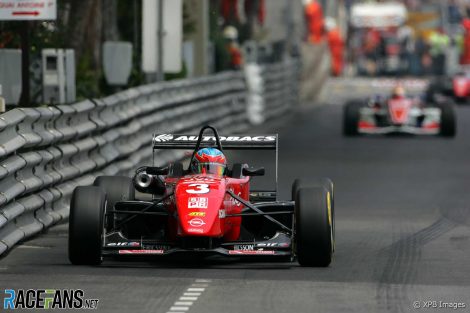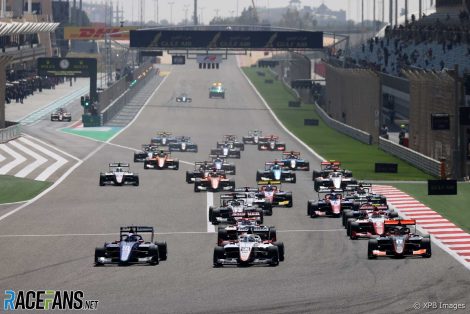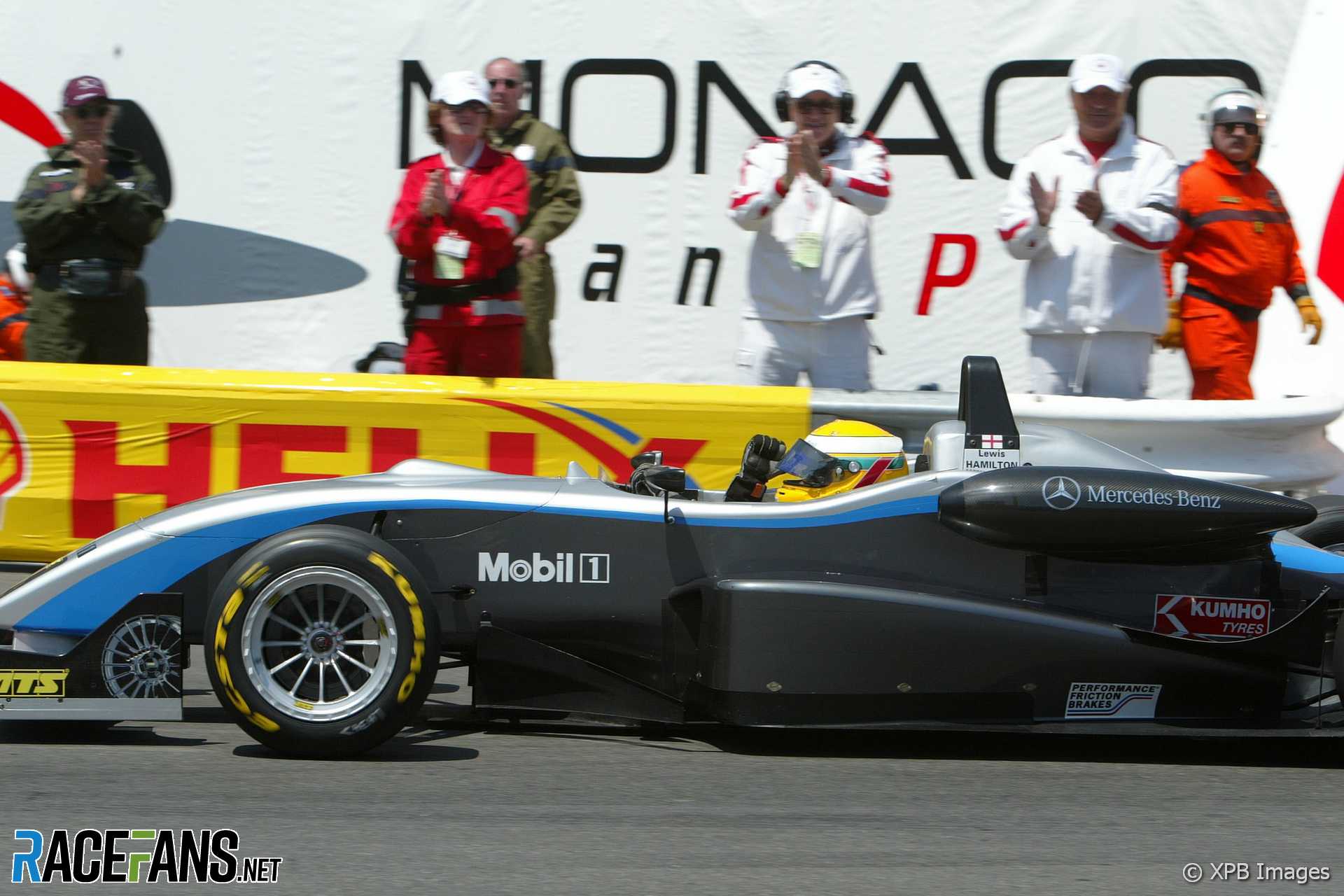Next weekend, contemporary Formula 3 cars will race on the streets of Monaco for the first time since 2005.
The 30-strong field of FIA Formula 3 drivers will vie to succeed Lewis Hamilton, who dominated on the Monaco streets 18 years ago.
The category has a long history in the city. Non-championship races were held there from 1964 to 1969, which quickly became one of the most significant events in junior single-seater racing.
F3’s road to return in Monaco
Monaco’s F3 race was incorporated into various championships on all bar two occasions between 1970 to 1978. After that it returned to being a non-championship spectacle until 1997, its place on the support bill of the country’s grand prix taken at one stage by International Formula 3000.
An array of other junior categories have supported F1 in Monaco. F3000 was replaced by its successor GP2 in 2005, which evolved into F2 six years ago.The Formula Renault V6 Eurocup held races in 2003 and 2004, before handing its space over to the GP2-rivalling Formula Renault 3.5 series, which harked back to the old days of Monaco support action by only holding a single race each time it supported the event from 2005 to 2015.
Its place was then taken by its own FR2.0 Eurocup feeder series, and after that championship came to an end the mantle was passed on to the Formula Regional European Championship. But after only two outings in Monaco it was determined last year that it would not return to the principality’s streets for 2023.
That left space for another series to swoop in. F2 promoter Bruno Michel spoke with Automobile Club de Monaco, the event’s organiser, to bring his FIA F3 championship onto the bill. In addition to F2/GP2, Michel previously brought FIA F3’s predecessor series GP3 to Monaco back in 2012.
But the arrival of the modern F3 series poses a new challenge. While GP3 brought 26 cars, F3 will up the total to 30. That’s 50% more than will tackle the grand prix around a track which is both the narrowest and shortest on the calendar.
The F3 field will be split into two groups of 15 for qualifying, with each group getting 16 minutes on track. Pole position for the feature race will go to the fastest driver in qualifying, then the remainder of their group will fill the odd-numbered grid slots based on order of pace. Whoever topped the slower group qualifies second, with the rest of that group’s drivers occupying the even-numbered grid spots.
The sprint race grid will be set by reversing the top ten qualifiers – a change from the series’ usual format of reversing the top 12.
Advert | Become a RaceFans supporter and
F3’s last visit to Monaco
F3 looked very different when the Euro Series visited Monaco in 2005, primarily because back then it was a worldwide open-engine category rather than a single spec series on Formula 1’s support bill.

There were 11 teams and three different engine manufacturers present on the 23-car Euro Series grid in Monaco. Among those joining Hamilton on the grid were fellow future multiple-time F1 world champion Sebastian Vettel.
Other future stars in the 2005 F3 field included 2016-17 Formula E champion Lucas di Grassi, 2009 Super Formula champion Loic Duval, 2010 DTM champion Paul di Resta, two-times Super GT champion Kohei Hirate and multi-discipline star Esteban Guerrieri.
Di Grassi and Di Resta were team mates at Manor Motorsport, while Hamilton was paired with another future Formula 1 driver, Adrian Sutil, at ASM. The French team, run at the time by future Ferrari team principal Frederic Vasseur, is now known as ART Grand Prix.
Hamilton took the chequered flag first in five of the first six races of the season. However he lost one of those wins, at Spa-Francorchamps, when he and seven other drivers were disqualified for technical infringements relating to the dimensions of their cars’ diffusers.
Besides his loss in that race, to Sutil, Hamilton’s only other defeat had come in the second race at Hockenheim, where he finished third behind Signature pair James Rossiter and Duval.
That meant Hamilton arrived in Monaco as the firm favourite. However he faced some additional pressure as the McLaren junior would be racing at the same track as his backers for only the second time in his career.

Advert | Become a RaceFans supporter and
The attention on GP2 meant F3’s field of future world champions did not get the same amount of focus. The location of the support paddocks ensured the F3 teams got a different kind of glamour to what the F1 fraternity enjoyed.
“We were in the circus tent in 2005 [where] the Porsche Supercup are now,” recalls Pete Sliwinski, who was director of and engineer for the Manor team that Hamilton had driven for in 2004. “It wasn’t too far [from the track]. If I remember right, we came out of the tunnel at Rascasse – so it wasn’t too bad.”
The tent is located at the very southern point of the tiny principality, 1.5 kilometres away from the pit lane. F2 is based in the multi-storey Chemin des Pecheurs car park perched above the coastal promenade, squeezed somewhat between the local aquarium and F1’s paddock.
But F3 this year could be placed even further away if F2 keep their car park and the sports cars stay at the circus. To fit in FREC’s 37 cars last year, their paddock was placed in a car park at the Monte Carlo Country Club almost three kilometres away in France.

As in 2005, F3 is ending a long absence from the circuit by racing in Monaco this year and that means nobody has any relevant data to hand on how to set up the cars for the tight and twisty track. But it may be more similar to conventional, permanent circuits than might be expected.
“Engineering-wise, Monaco was probably one of the smoothest tracks you go to. Especially being a street circuit – just loads of downforce,” Sliwinski explains.
“Monaco is okay the first time you go, but after that it’s not in first place on your list of favourite tracks [for an engineering challenge]. GP3 went there in 2012, which is basically what FIA F3 is now. It’s nothing like the proper F3 cars of 2005.”
Advert | Become a RaceFans supporter and
Four of the current FIA F3 teams were in Monaco for GP3’s sole visit there, three more were at the track – and in the French car park – for FREC last year. Of those seven, only ART GP and Prema were also on the 2005 F3 Euro Series grid. So there may be limited technical relevance to look back on, but the racing itself on F3’s last Monaco trip is worth remembering and may give an insight as to what to expect now.
As it is now, F3 was the place for F1 juniors to be before they made it to F2. McLaren had Hamilton, Red Bull backed Vettel and Renault supported Di Grassi and Duval. Drivers only got 30 minutes of practice, compared to 45 now, and they had to get to the track extra-early on Friday as qualifying began at 8am. This time the F3 paddock don’t have to be on track for their qualifying until 11:10am, but their feature race on Sunday starts at 8:20am.
Hamilton led Sutil by 0.878 seconds in practice back in 2005, and improved his pace further in qualifying to take pole by a healthy margin of 0.609s over his team mate. Duval was a further 0.114s behind in third, and the trio kept their positions throughout Friday’s 18-lap race.
A strong start meant Hamilton held the lead into the first corner, and could only create a small gap over Sutil before a mid-race Safety Car period put his team mate right back on his gearbox. But there was simply no room to overtake, and Sutil finished 1.777s behind. A relieved, and victorious, Hamilton said afterwards that Sutil had been “extremely fast” and he had found it “really difficult to keep him behind”, while Duval had been busy keeping Rossiter at bay and finished 12.525s back in third place.
While Monaco is no wider than 18 years ago, the fact that F3 now uses reversed grids may not only make overtaking ‘easier’ but also potentially set up a proper victory fight in the Saturday sprint race with slower cars starting ahead of faster ones.

It was another lights-to-flag win, but also another stressful one. Hamilton hit the barriers at the exit of the Swimming Pool chicane mid-race, and though he kept his lead, Sutil closed in. However when Sutil tried to pass him for the win at Sainte Devote he ended up crashing out, freeing Hamilton to win by 7.644s over Duval.
Only 13 cars made it to the finish on the lead lap, with many drivers being caught out by the closeness of the barriers on their first ever time racing around Monaco. It will be a new track for the majority of the 2023 F3 grid too, and they are racing wider cars with bigger tyres that reduce front and rear visibility.
Expect drama and potentially a spot of chaos as drivers familiarise themselves with a unique and demanding circuit. But there’s also an opportunity for one driver to make the most of it and take a headline-grabbing win or – or perhaps even two – as Hamilton did on his way to F1.
Advert | Become a RaceFans supporter and
Formula 3
- Prema announce move into IndyCar with new two-car team in 2025
- Beganovic passes Fornaroli and Mini for Australia feature race victory
- Red Bull junior driver’s track limits penalty cancelled by stewards
- Stenshorne holds off Lindblad for first F3 win in sprint race
- Fornaroli pips Mini in late scramble for pole after Meguetounif crash





Jere (@jerejj)
20th May 2023, 16:19
I noted an interesting detail in the opening image:
Hamilton raced under the English flag at the time rather than Union Jack.
More relevantly, having just looked through the 2005 Euro F3 field, indeed, many familiar names, both drivers who eventually reached F1 & who didn’t.
I wonder how all those who never reached F1 must’ve felt when two drivers from the same field eventually started winning championships on the highest circuit-racing level.
Matthijs (@matthijs)
22nd May 2023, 9:39
@jerejj Of that F3 field in 2005 eventually 6 drivers managed to make it to F1, although Di Grassi and Vd Garde didn’t last long in F1.
Jere (@jerejj)
22nd May 2023, 9:44
@matthijs Indeed